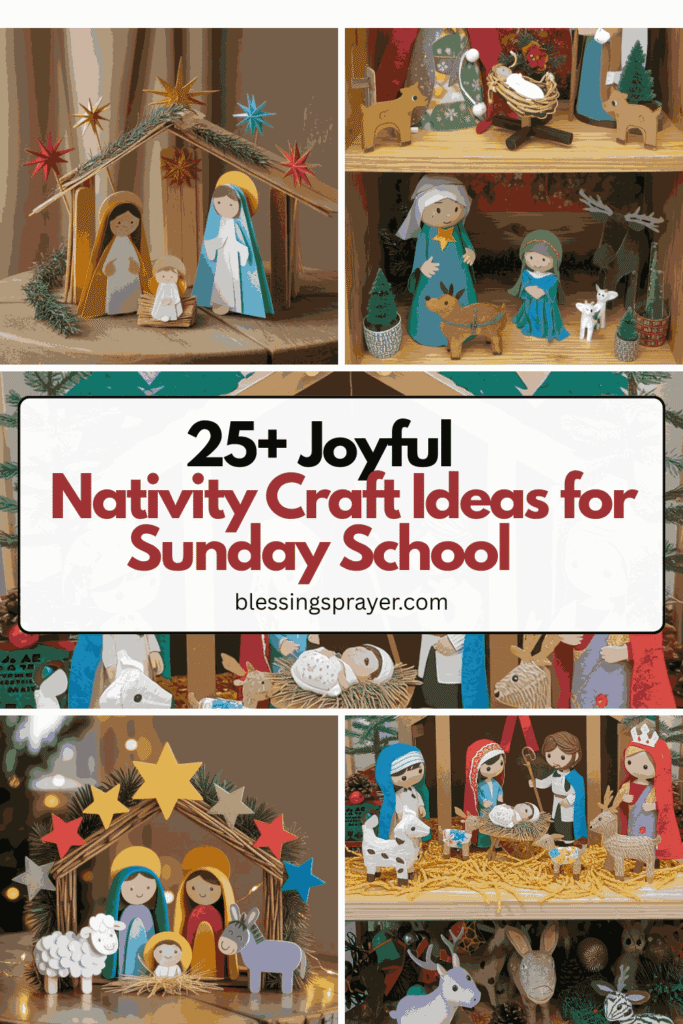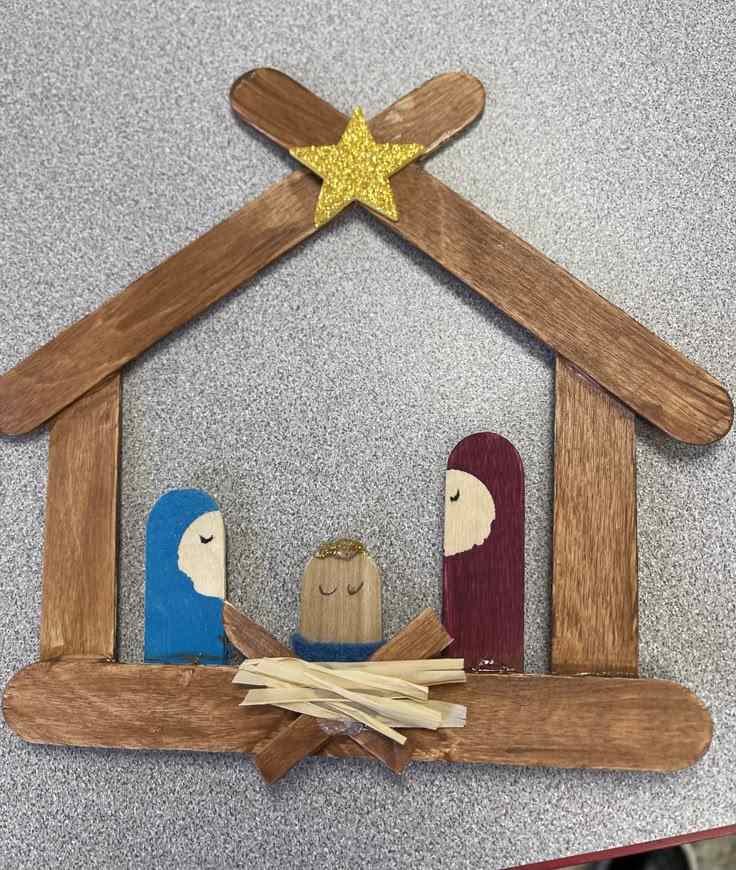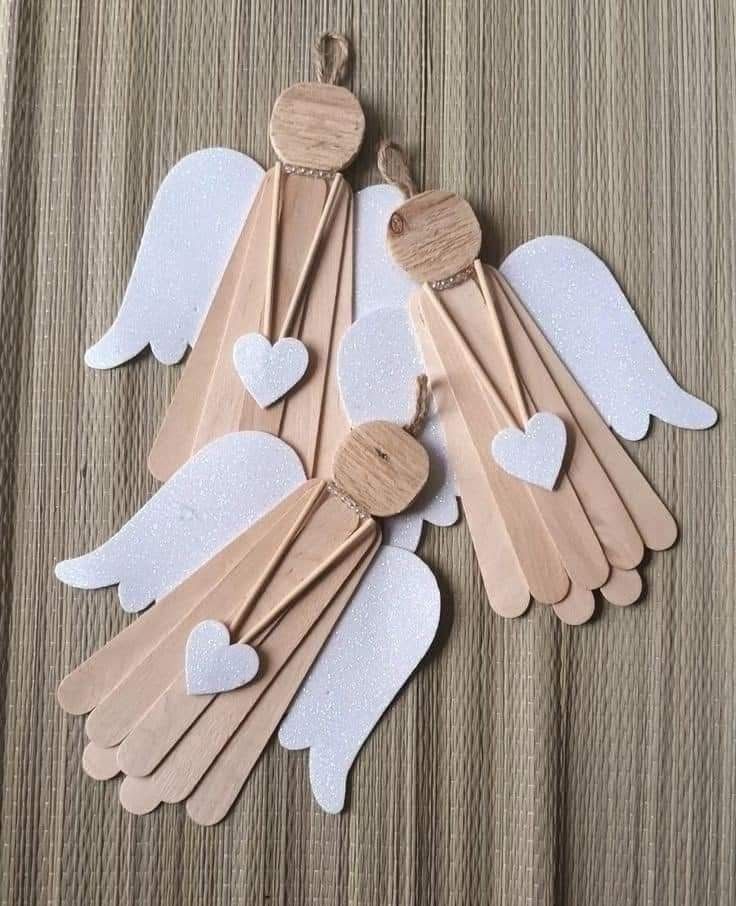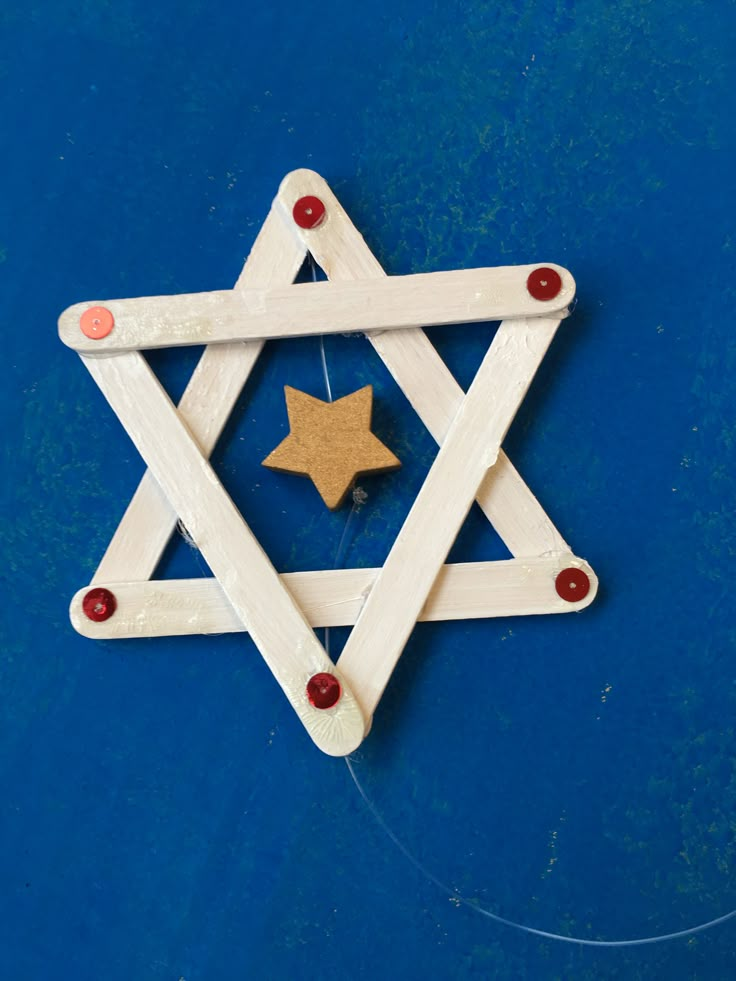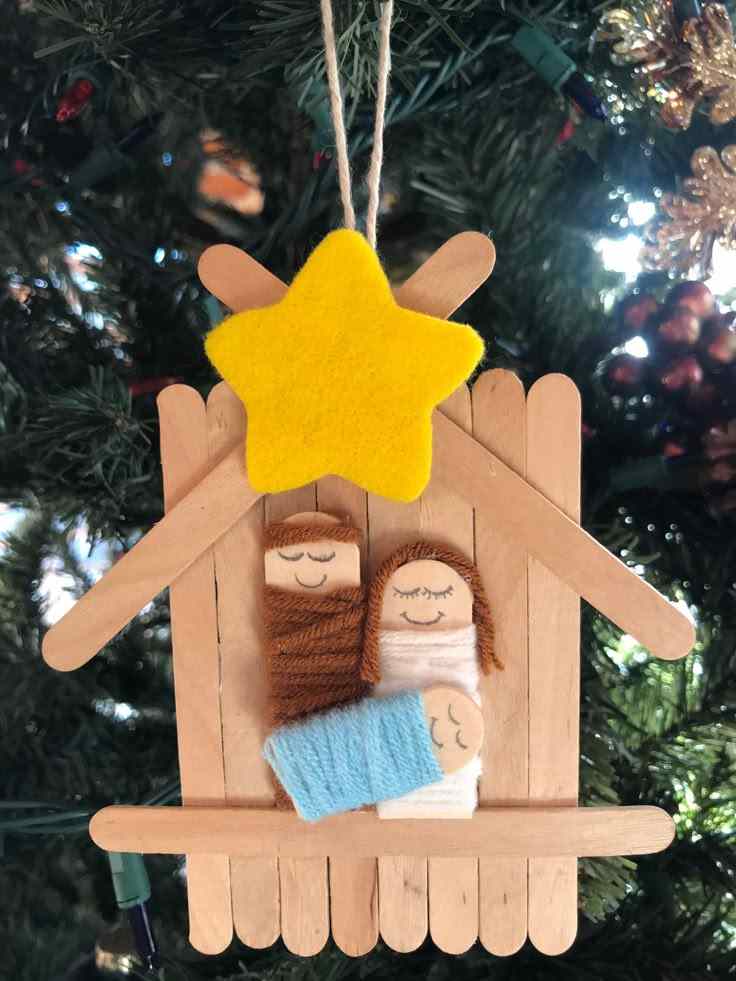When I think about teaching the story of Jesus’ birth, I always try to make it hands-on and memorable for the kids. Nativity crafts have been a wonderful way to do that. Honestly, there’s something special about letting children create their own little scene — whether it’s Mary, Joseph, baby Jesus, or the shepherds and wise men. It turns the story from words on a page into something tangible they can touch, see, and even play with a little afterward.
I’ve found that crafting together also opens up moments for conversation about the meaning behind each figure and the significance of Christ’s birth. Even simple materials like paper, clay, or popsicle sticks can bring the nativity to life. In my opinion, these crafts don’t have to be perfect; what matters is the joy, engagement, and faith-building that happens along the way. It’s truly a highlight of our Sunday School activities.
Nativity Craft Ideas for Sunday School
Popsicle Stick Manger Scene
Source: Pinterest
Using popsicle sticks, kids can create a stable, then place small cutouts or figurines inside. I love watching how differently each child decorates theirs. Some add glitter stars or cotton “hay,” making each scene unique. Honestly, it’s simple but effective, giving kids a tangible connection to the nativity story. To be fair, even the youngest can manage it with a little help, and the finished pieces make adorable keepsakes for home or Sunday School displays.
Cotton Ball Sheep Craft
Kids glue cotton balls onto paper or cardstock to create fluffy sheep for the nativity. I’ve found that adding little eyes and feet makes the animals come alive. Honestly, it’s always fun seeing how much personality each child gives their sheep. This craft teaches attention to detail and gives context to the shepherds’ role. Displayed around the nativity, these little sheep create a lively, interactive scene that kids feel proud of.
Paper Roll Wise Men
Empty toilet paper rolls can be transformed into wise men by wrapping them with colorful paper and adding small crowns. Honestly, the kids get creative with robes and gifts. It’s simple, inexpensive, and allows children to explore color, pattern, and design while learning about the story. I’ve found that arranging them around a manger makes the nativity scene feel complete and festive.
Popsicle Stick Angel
Source: Pinterest
I’ve helped kids make angels from popsicle sticks by gluing on paper wings, a small head, and decorating with glitter or stars. Honestly, they love adding halos or tiny Bible verses. This craft is perfect for teaching about the angelic announcement to the shepherds while giving children a hands-on, creative project. Angels made this way can also hang on classroom walls or Christmas trees, keeping the story alive.
Handprint Manger
Tracing kids’ hands to form a manger shape is simple yet meaningful. I often have children use brown or yellow paper for the hay and cutouts of Mary, Joseph, and baby Jesus. Honestly, it’s adorable to see little hands turned into part of the nativity scene. This craft emphasizes that everyone has a role in God’s story, no matter how small. It’s quick, easy, and creates keepsakes that parents love to display at home.
Popsicle Stick Nativity Scene
I love using popsicle sticks for a simple nativity. Kids can glue sticks to form a stable, then paint or decorate it with small figures of Mary, Joseph, and baby Jesus. Honestly, it’s always fun to watch their creativity flow. Some kids add little straw beds or glittery stars, which makes every scene unique. Even though the materials are basic, the results feel special. It’s hands-on, keeps their attention, and helps them remember the story better. To be fair, these crafts are easy to prep and can be done in one session. Each child gets to take home a mini nativity, making it a meaningful keepsake and a wonderful way to connect craft time with faith.
Paper Plate Nativity
Using a simple paper plate as a base, children can create a manger scene with cutout figures. I often have them color or glue in details like hay, animals, or a star. Honestly, I’ve found that kids really enjoy arranging the characters themselves — it gives them a sense of ownership in retelling the story. This craft is inexpensive and encourages creativity, plus it’s sturdy enough to hang on walls or bulletin boards at the church. Even the simplest plate can be transformed into a beautiful, faith-filled piece of art.
Felt Nativity Ornaments
I like cutting simple felt shapes to make nativity ornaments — tiny stars, crosses, and little figures. Kids can glue or sew the pieces together. To be fair, it’s a bit fiddly, but they love the process and seeing the finished ornament hang on the tree. These crafts double as Christmas decorations, letting children celebrate while remembering the story of Jesus’ birth. They’re soft, colorful, and make perfect gifts for family members.
Paper Cone Christmas Tree Nativity
I sometimes use paper cones to create Christmas trees as part of a nativity scene. Kids decorate them with glitter, stars, or small stickers. Honestly, it’s fun to see how each child personalizes their tree while learning about the environment around Jesus’ birth. I’ve found that combining the trees with paper figurines of Mary, Joseph, and baby Jesus creates a mini scene that feels alive and celebratory.
Handprint Nativity Scene
Tracing children’s hands to form a nativity shape is always memorable. I’ve found it exciting when kids see their handprints transformed into a manger, hay, or animals. Honestly, it’s simple but leaves a personal touch that families cherish. It also emphasizes the idea that everyone has a role in God’s story, no matter how small.
Popsicle Stick Star of Bethlehem
Source: Pinterest
Using popsicle sticks glued in a star pattern, kids can decorate with paint, glitter, or foil. Honestly, they love placing it atop a mini nativity or on the wall. I’ve found it reinforces the story of the guiding star in a visual, interactive way. This craft is easy, inexpensive, and allows children to focus on the symbolism of Christ’s birth.
Clothespin Nativity Figures
Clothespins make perfect bases for Mary, Joseph, and baby Jesus. Kids paint or wrap them with cloth or paper to create the figures. Honestly, I enjoy seeing the creative variations each child produces. To be fair, adding small details like yarn hair or mini stars makes them extra charming. These figures can stand on shelves, mantles, or even be used as play props during storytelling.
Popsicle Stick Manger Animals
Animals like cows, donkeys, and sheep can be made from popsicle sticks glued in various ways. Kids add details with markers or paint. Honestly, it’s fun seeing them design their own little stable companions. This craft reinforces the nativity story’s setting while giving children an engaging, hands-on activity that strengthens storytelling and motor skills.
Paper Cup Manger
Paper cups can become stables by cutting and decorating them, then filling them with hay or cotton. Honestly, kids love placing figurines inside and adding small animals around the scene. I’ve found that this simple craft produces a 3D nativity children can interact with while retelling the story. It’s inexpensive, easy, and gives a personal keepsake.
Foil Star Ornaments
Cut stars from foil and decorate them with markers or stickers. Honestly, kids enjoy shiny crafts, and adding a small nativity figure beneath the star emphasizes Christ’s birth. I’ve found that hanging these stars from classroom ceilings creates a festive, faith-focused environment. It’s simple, beautiful, and a reminder of the first Christmas night.
Yarn Wrapped Manger
Source: Pinterest
I sometimes have kids wrap popsicle sticks or cardboard shapes with yarn to create a manger effect. Honestly, it’s tactile, calming, and engaging. Adding small figurines inside completes the scene beautifully. I’ve found that kids enjoy the process of creating texture and color while connecting with the nativity story.
Paper Mosaic Nativity
Kids can tear colored paper into small pieces and glue them to form nativity figures. Honestly, I love seeing how their patterns emerge uniquely. This craft is great for teaching patience, focus, and artistic expression while keeping the story of Jesus’ birth at the heart of the activity.
Stained Glass Nativity Craft
View this post on Instagram
Using tissue paper and black cardstock outlines, kids can make “stained glass” nativity scenes. Honestly, the colors are always vibrant and uplifting. I’ve found that letting children place each colored piece themselves makes them feel proud and engaged, and the finished craft looks like a beautiful, faith-filled decoration.
Clay Nativity Figurines
Air-dry clay is perfect for making tiny figures of Mary, Joseph, and baby Jesus. Kids can shape and mold each character themselves. I love seeing how differently each child interprets the figures. Honestly, the imperfections make them feel handmade and heartfelt. Once dried, the figurines can be painted or left plain for a minimalist look. This activity teaches patience and fine motor skills while keeping the focus on Christ’s birth. It’s hands-on, memorable, and gives children a tangible way to connect with the nativity story.
Toilet Paper Roll Manger
I’ve used empty toilet paper rolls as bases for a manger craft. Children decorate them with brown paper or paint, then add small cutout figures inside. Honestly, it’s always funny seeing how creative they get with these simple rolls — some make roofs, some add animals. It’s inexpensive, engaging, and gives kids a 3D scene they can take home. I’ve found that little touches like glitter stars make it even more exciting.
Salt Dough Nativity Figures
Salt dough is a classic for a reason. Kids mix, shape, and bake their own nativity figures. I love how they proudly show off their baby Jesus or wise men afterward. To be fair, it takes a little time, but it’s worth it because the kids remember the story better when they’ve made it themselves. These figures can be painted and displayed at home, making the nativity feel alive in a hands-on way.
Popsicle Stick Star
Cut and glue popsicle sticks into a star shape, then decorate with paint or glitter. I’ve found that adding a tiny nativity scene beneath the star makes it extra meaningful. Honestly, it’s always magical to see kids’ eyes light up when the star is complete. It’s simple, affordable, and reinforces the guiding star story from Jesus’ birth.
Felt Nativity Scene
View this post on Instagram
Cut simple shapes from felt for Mary, Joseph, baby Jesus, and animals. Kids arrange and glue them on a base. Honestly, it’s always exciting seeing how they create their own stable scene. Felt is forgiving, easy to work with, and provides a tactile, soft experience for little hands.
Paper Bag Shepherd Puppets
Kids can use paper bags or craft sticks to create shepherd puppets, complete with sheep or crooks. Honestly, they love acting out the nativity story afterward. It’s playful and educational, helping them understand the shepherds’ role in welcoming Christ. I’ve found that puppets spark imaginative storytelling and make the lesson more memorable. These puppets can even be used in a small Sunday School play.
Nativity Coloring Sheets
Sometimes simplicity is best. I print nativity coloring pages and encourage kids to add their own elements like stars or animals. Honestly, coloring keeps everyone focused and allows for personal interpretation of the story. It’s easy, low-prep, and can be paired with short discussions about the Scripture behind the scene. I’ve found that children often add creative details that make each page uniquely theirs.
FAQ
What materials are best for Sunday School nativity crafts?
For Sunday School, I usually stick to safe, easy-to-handle materials like paper, felt, popsicle sticks, tissue paper, and non-toxic glue. These allow kids of all ages to participate and are inexpensive. I’ve found that having a variety of textures keeps the crafts engaging while still being manageable for small hands. Simple materials often produce the most meaningful results because the focus is on creativity and storytelling rather than perfection.
How can I adapt nativity crafts for different age groups?
You can scale complexity based on age. Younger children might color pre-cut shapes or glue simple pieces together, while older kids can cut, paint, or assemble 3D scenes. I try to give options so every child can participate meaningfully. Including elements like stickers, glitter, or small figurines can make the craft appealing across age ranges.
How do I display completed nativity crafts?
I like creating a small “Nativity Corner” in the classroom or church lobby. Finished crafts can be set on tables, hung on walls, or arranged as a collective display. It makes the story visual and gives children a sense of pride. Lighting or background cloths can enhance the scene and make it feel special.
Can these crafts be sent home as keepsakes?
Absolutely! I encourage kids to take their crafts home to share with their families. It reinforces the Christmas story and gives parents a tangible reminder of faith-filled activities their children enjoyed. I’ve found it also sparks conversations about Christ’s birth at home.

I’m father joaquin perez, we are a catholic church with all the sacraments where everybody is welcome. we celebrate catholic mass every Sunday at 12:30pm at saint stephen episcopal church at 2750 McFarlane road, Miami, Florida

